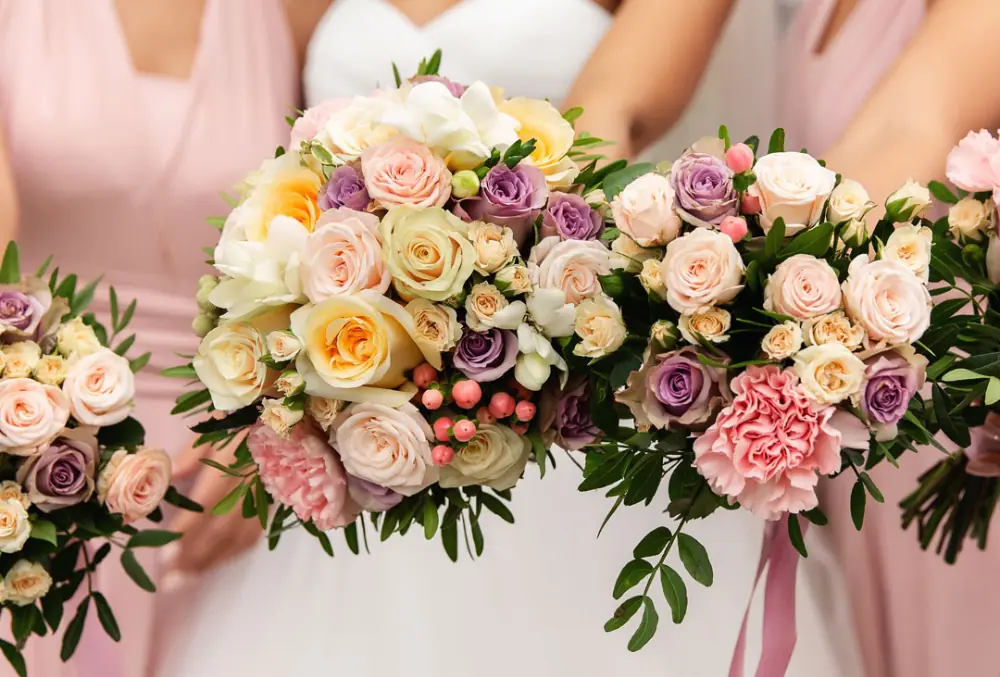Wedding flowers enhance marriage celebration with beauty, grace, and a hint of nature. Flowers are crucial to the wedding décor, from boutonnieres and bouquets to centerpieces and floral arrangements. Still, there’s frequently disagreement over who should pay for the wedding flowers.
The bride’s family was traditionally responsible for covering the costs of the wedding flowers. But things have changed, and over time, the realities of funding the costs of wedding flowers have changed, and sharing the cost has become more typical for engaged couples and their families.
The payment obligation for wedding flowers, in particular, can change based on certain aspects. The couple themselves may frequently decide to cover the cost of the flowers, or both parents may pitch in to help. Ultimately, the choice is based on personal tastes, financial situation, and circumstances.
Continue reading to learn more about the nuances over this topic.
Conventional Courtesy and Wedding Expenses
Regarding conventional etiquette around wedding expenses, it’s crucial to comprehend whose responsibility it is to cater for wedding flower costs. Below is a brief breakdown:
- Bride’s Family – Traditionally, the bride’s family is responsible for covering the costs of all the flower arrangements for the ceremony, plus the reception.
- The Groom’s Family – Even though tradition dictates that the bride’s family is supposed to cater for the floral costs, the groom’s family may chip in and help, especially if they’re hosting the rehearsal dinner or have specific preferences.
- The Couple – The soon-to-be-married couples may decide to allocate a share of their wedding budget to cater for floral costs.
It’s important to note that in current times, flower cost responsibilities may vary and be flexible, mainly depending on specific circumstances, the couple’s preferences, and their immediate family.
Who Usually Covers the Cost of Wedding Flowers?
The tradition of who’s typically supposed to cater for the cost of wedding flowers varies from culture to culture, depending on personal preferences and regional customs. Historically, and in many cases, the bride’s family has always taken responsibility for catering for wedding flower costs. But things have changed over the years.
It’s common to find the soon-to-be couples catering for wedding flower costs alone, while some may choose to split these costs between families. Ultimately, decisions that revolve around who’s supposed to cater for wedding flower costs are personal, and the best decision should be based on what works best in the interest of the couple and their immediate families.
Modern Approach: Cost Sharing
Unlike a few decades back, sharing wedding flower costs is now a trend that’s picking up in many places across the globe. Lately, couples are assuming a more equitable and collaborative approach to financing wedding flower expenses.
At this point, we’ll focus on two key aspects: dividing the expenditure between the couple’s expenses and the donations from family members. Be ready to see how this contemporary method changes the conventional dynamics of wedding costs.
Dividing Wedding Flower Costs between Couples
Sharing wedding flower costs between couples is a fair and ideal approach, allowing both partners to make equal contributions. Here’s how couples can split wedding flower cost expenses:
- After discussing it with your partner, decide on a budget for the wedding flowers.
- Choose the kinds and numbers of flowers required for the ceremony and reception.
- Compute the entire cost of the flowers, considering bouquets, corsages, and arrangements.
- Establish the financial contribution that each partner will make towards the flower budget.
- Think about dividing the work of finding florists, scheduling appointments with suppliers, and coming to a decision.
- Maintain a close eye on all expenditures and be upfront about any adjustments or unforeseen charges.
- Remember to respect and encourage one another’s opinions and conclusions throughout the process.
Family’s Contribution
The bride’s and the groom’s family can also contribute towards the cost of wedding flowers. When it comes to family contributions, here’s what you need to consider:
- Financial Capability – Determine if the family is in a position to cater for the wedding flower costs.
- Dynamics of Relationships – Try to assess the closeness or distance of the relationship between the couple and their immediate families since such can influence their willingness to contribute.
- Traditional and Cultural Expectations – Some traditions and cultures have certain expectations on the family’s responsibility in handling wedding flower costs.
- Communication – Discuss your financial expectations openly with family members to avoid any assumptions or misunderstandings.
5 Practical Ways to Save on Wedding Flower Costs
Here are a few tips you can follow to save on wedding flower expenses.
1. Consider the Do-It-Yourself (DIY) Approach
Making your wedding flower arrangements may be an enjoyable and economical (DIY) project you can use to save on wedding flower costs. You may reduce the costs further by growing the flowers in your garden.
2. Opt for Local or Seasonal Flowers
Going for local or seasonal flowers comes with several benefits such as: cost-friendly, more widely available and access to the freshest flowers.
You can make a unified and aesthetically beautiful floral arrangement using seasonal flowers, which frequently match the season’s colors and themes.
3. Inquire around for a Lower Price
If you know what to ask for and how to ask for it, the market is always in your favor. Even if you’re searching for the best deal, being honest about your budget is essential.
In case you didn’t know, many florists are more than happy to assist couples who are organizing a wedding on a limited budget.
4. Be Flexible and Work with your Florist Early During the Planning Process
Being flexible is another way to reduce your total wedding floral costs. For instance, buying a color scheme instead of particular flower varieties frequently results in financial savings.
By saving money on similar goods and services, you’re thinking about, working with your florist early on can help minimize the cost of your wedding flowers as well as your overall expenses.
5. Set a Budget for your Wedding Flowers and Stick to It
The biggest issue that most couples face is the absence of a reasonable budget. Most couples either don’t have enough money set aside for flowers or have already spent it on other things.
Setting a budget, sticking to it and tracking every expense would be key to ensuring you don’t overspend on other items.
Conclusion
You get to enhance the mood of your wedding with essential decorations like aisle or chair decor, arch flowers, and entryway decor. Flowers help enhance and uplift the mood of a wedding. And even though the bride’s family usually pays for these necessary flower arrangements, things have changed with time, and the groom’s family can now contribute towards the cost of wedding flowers.


